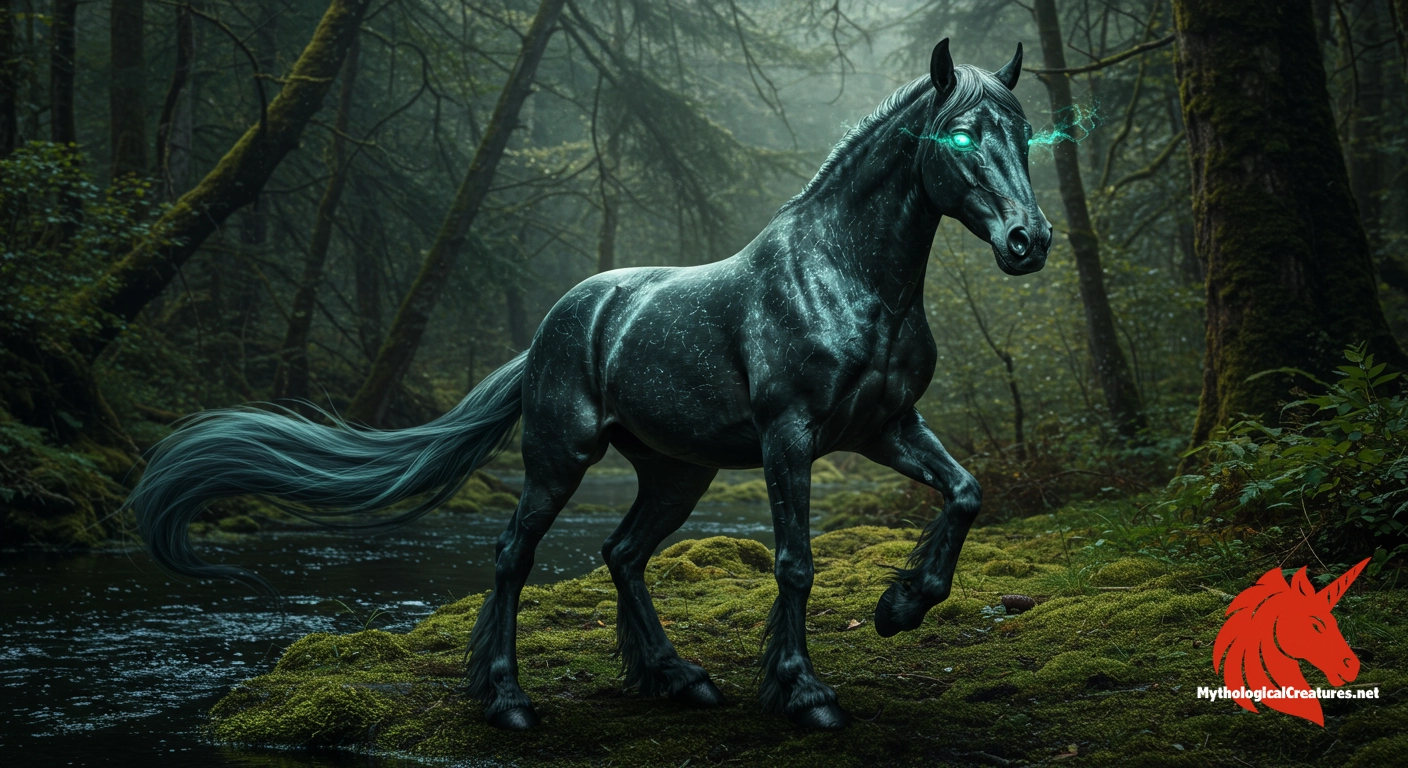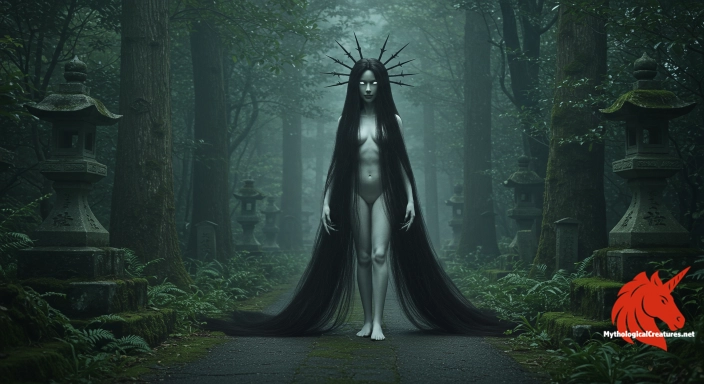Water horse: The Water Horse is a mythical equine spirit from Celtic folklore, renowned for its shape-shifting abilities and association with dangerous, freshwater bodies.

Water horse
Water horse - Serves as a cautionary symbol of the dangers lurking in natural waters and the deceptive allure of the supernatural.
Origins & First Encounters
The water horse is a captivating mythic being whose origins lie deep in the traditions of Celtic folklore, emerging as a spectral equine linked intrinsically to the watery landscapes of Britain and Ireland. Its diverse appellations, including Ceffyl Dŵr, Capaill Uisce, bäckahäst, each-uisge, and kelpie, reflect a rich tapestry of regional lore and linguistic heritage. Rooted in ancient oral traditions, the water horse has been regarded both as a beautiful creature of the water and as a harbinger of danger, embodying the dual nature of its environment. Early attestations of the water horse trace back to the rustic narratives of rural communities that revered and feared the mysterious allure of water. Over generations, it became enveloped in legends that spoke of seduction, transformation, and the peril that awaits those drawn too near. Its myth has always been intertwined with the unpredictable temperament of natural water bodies, symbolising both life and destruction. The creature’s elusive presence in historical records has contributed to its reputation as an ever-changing, formidable spirit of the deep. As storytellers passed its legend down through the ages, the water horse evolved into a symbol of nature’s hidden power and mystery. Its enduring appeal lies in its ability to evoke both wonder and trepidation, capturing the imagination of those who encounter its lore. Even today, tales of the water horse continue to inspire modern narratives and artistic interpretations that resonate with its ancient mystique.
Source Texts & Tale Variants
The narrative of the water horse is preserved through a wide array of historical texts and oral accounts compiled over centuries. Folkloric anthologies recorded by early enthusiasts and folklorists have captured various versions of its tale, each enriched by the perspective of the local community. Many traditional stories emerged from Scottish, Irish, and Welsh sources, often conveyed through lyrical ballads and spoken lore. Manuscripts and early written records have occasionally detailed fascinating encounters with this elusive creature, suggesting its deep-rooted impact on the cultural consciousness. These accounts tend to blend elements of caution and wonder, narrating the creature’s ability to enchant unsuspecting travellers. Over time, different storytellers introduced embellishments to the basic myth, leading to a multiplicity of narrative variants. Some versions cast the water horse as a benign, even protective spirit, while others highlight its lethal and deceptive nature. Collections of folk tales from the Victorian era and later periods further cemented its role in literature and popular culture. The diversity of its presentation in texts represents the dynamic interplay between oral tradition and literary adaptation. In this way, the water horse continues to be a subject of fascination, its legend evolving through successive generations and varied storytellers.
Form & Powers
The water horse is often depicted with an almost unworldly elegance, its sleek, glistening coat mirroring the reflective surface of tranquil waters. Its eyes are described as deep, enigmatic pools of liquid mystery that seem to capture the very essence of the sea. In many illustrations, the creature’s mane and tail cascade like fluid silk, blurring the lines between solid form and the shimmering currents of its habitat. There are accounts that describe it as having subtle anomalies—a set of webbed hooves or an elongated, almost serpentine form—suggesting adaptations to an aquatic life. The entity’s appearance can oscillate between the idealised beauty of a noble steed and a more eerie, supernatural countenance. In some traditions, the water horse appears to exude a ghostly luminescence, with its outline sometimes merging into a halo of mist and foam. Its physical form is not fixed; the creature is believed to be capable of shape-shifting, further heightening its mysterious allure. Sizes vary in different tales, ranging from a modest, nimble horse to a towering, almost monstrous presence. This mutable appearance reinforces the idea that the water horse is a living embodiment of the fluid, ever-changing nature of water itself. Ultimately, its detailed physical descriptions serve as both an invitation and a warning—a call to admire and a caution against the deceptive beauty of nature.
Regional Faces
Across the Celtic regions, the water horse adopts a myriad of forms and attributes that reveal the unique cultural influences of each area. In Scotland, the creature is most famously known as the kelpie—a spectral, shape-shifting horse that haunts freshwater lochs and streams, luring unwary souls to a watery end. In Ireland, the each-uisge takes on a slightly more tragic aspect, embodying both the enchanting beauty and the ominous peril of untamed waters. Welsh traditions speak of the Ceffyl Dŵr, wherein the creature hints at an almost sacred role as a guardian of mystical water sites. In contrast, Scandinavian lore presents the bäckahäst as a reminder of the natural world's wild and unpredictable forces, often portrayed with a blend of menace and grace. Even within these distinct narratives, the core motif remains consistent—a creature that seamlessly fuses the allure of beauty with an inherent warning of danger. Regional adaptations frequently mirror local geography and historical experiences, imbuing the legend with layers of meaning that echo the values and fears of the community. Some regions even recount stories where the water horse exhibits moments of benevolence, suggesting a balance between its destructive and protective roles. The rich variety in its portrayal across different cultures highlights the universal human need to both celebrate and caution against the mysterious forces of nature. Thus, each tradition contributes its unique brushstroke to the enduring, multifaceted portrait of the water horse.
Cultural Parallels
When one examines the water horse alongside other mythical entities, its unique blend of grace and menace stands out as a remarkable regional interpretation of a universal archetype. It shares intriguing similarities with the selkie, another shape-shifting being from coastal folklore, which also toggles between human and marine animal forms. In the broader mythological panorama, comparisons can be drawn with the hippocampus of Greek lore—a creature that blends the elements of equine beauty with the mystique of the sea. Both the water horse and these parallel beings encapsulate the ambivalence inherent in nature, where beauty is invariably interlinked with a hint of danger. This motif of duality resonates deeply across cultures, with numerous legends cautioning against the deceptive allure of nature. The destructive potential of such beings, evident in cautionary tales across maritime communities, mirrors societal concerns about the capriciousness of the natural world. Furthermore, the water horse’s transformative qualities invite comparisons with other shape-shifting entities that challenge conventional boundaries between animal and spirit. Its recurring themes of seduction, mortality, and the crossing of domains underline a shared narrative that spans geographic and cultural divides. These intertextual connections enhance our understanding of folklore as a living dialogue between disparate cultures. In this way, the water horse emerges as a powerful emblem of both regional identity and the broader human imagination regarding the mysteries of water and transformation.
Legacy & Modern Evolution
The water horse has experienced a profound evolution over time, transitioning from a fearsome cautionary figure in ancient lore to a cherished emblem in modern myth-making. Early narratives emphasized its role as a warning against the hazards of natural water, often painting it as a creature of ill omen that foreshadowed danger. As the centuries rolled by, subsequent interpretations began to reveal a more layered character—one that encapsulates both the beauty and unpredictability of nature. The Victorian era, in particular, saw the water horse adopted into romantic and gothic literature, where its tragic allure added a note of melancholy to its fearsome reputation. In contemporary settings, the creature has been reimagined in films, novels, and art, where it often embodies themes of environmental conservation and the timeless tension between mankind and nature. Modern adaptations tend to present the water horse as a misunderstood spirit, inviting audiences to appreciate the delicate balance between its seductive charm and its potentially perilous nature. This shift in portrayal reflects broader changes in societal attitudes toward the natural world and the reinterpretation of folklore in a modern context. The water horse now stands not only as a relic of myth but also as a dynamic, evolving symbol that continues to inspire creative reinterpretation. Its legacy is a testament to the enduring human fascination with the mysteries of water and the transformative power of storytelling. Through continual reinvention, the water horse remains deeply embedded in our cultural consciousness, challenging and enchanting us with its timeless mystique.
Interesting Fact
A unique aspect of the Water Horse myth is its multiple names across different cultures, illustrating a shared human fascination with the mysterious powers of water and transformation.
Quick Creature Info
Features:
Associations:
Our Mythic Legendary Rating:

Also Sometimes Known As:
Habitat:
Supernatural Powers:
Physical Attributes:
Abilities:
Behavior:
Weaknesses:
Lore:
Related Creatures, Tales or Lore
References
Discover Another Mythical Legend You May Not Have Heard Of?
Uncover the mysteries of ancient folklore and expand your knowledge of legendary beings from cultures around the world.
Dare to Meet the Harionago....
Mythical Disclaimer: The images and data on this site are derived from various historical and literary sources, but we have found that many myths often have multiple versions and interpretations across references, sometimes contradictory. As a result, these creature depictions are artistic interpretations—imaginative blends of folklore, legend, and a dash of AI guesswork. Because creature descriptions vary widely, our illustrations and accompanying information represent our best effort to honor mythology while bridging creative gaps. Enjoy these interpretations—just remember, we've done our best to respect the stories and validate available data, but in the realm of mythology, details often shift, imagination leads the way, and nothing is ever set in stone!
Curated by the Mythological Creatures Team (rev. May 2025)
